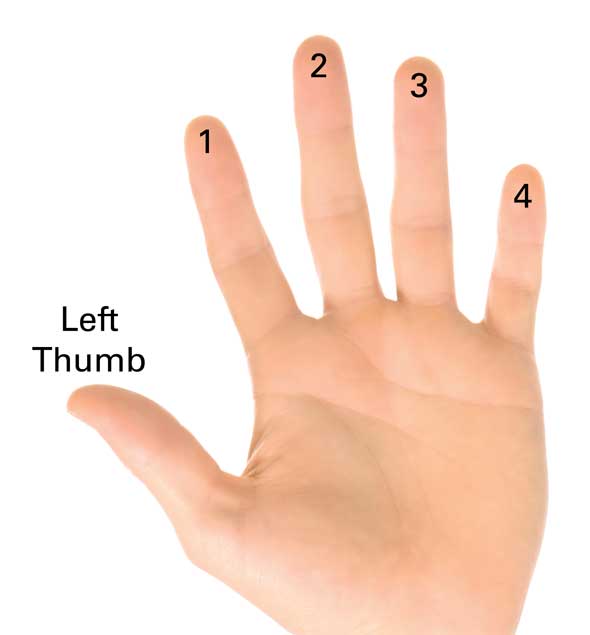
Using The Left Hand

The left hand fingers are numbered as such:
The left hand finger number, if needed,is written next to the music note.
Left Hand Placement

Your fingers should be on their tips and placed just behind the frets (not on top of them).

For greater support the left hand thumb should be placed behind the neck of the bass, approximately opposite your index and middle fingers as shown in the photo.
All the examples you have played so far have involved only the open strings. However, in all styles of bass playing you will frequently be required to use both open and fretted notes, often within the on bass line as shown here.

Chord Symbols
The letters above the staff in the above example are chord symbols. Chords are groups of notes played by the rhythm guitarist or keyboard player. The three most common chord types are major, minor (m) and seventh (7) chords. Chords will be discussed in more detail later in the book. Some examples of chord symbols are as follows:

The Half Note

This note is called a half note. It has a value of two beats.
There are two half notes in one bar of * time.
This example uses half notes along with quarter notes and quarter rests.

The Half Rest

This symbol is a half rest. It indicates two beats of silence.
Once again, remember to tap your foot and count as you play regardless of whether you see notes or rests in the music.

The Whole Note

This is a whole note. It lasts for four beats.
There is one whole note in one bar of * time.
The whole note is the longest note commonly used in music.
The Whole Rest

The whole rest indicates four beats or a whole bar of silence. The symbol for the whole rest is very similar to that of the half rest. The difference is that the half rest sits on top of the line, while the whole rest hangs below the line.
This example uses both the whole note and the whole rest. Be sure to use the correct fingering as shown below the tablature. The stretch involved here may be difficult at first, but in time this kind of movement will become easy if you practice regularly.

Left Hand Fingering
As a general rule:
- Play notes on the first fret with the first finger of your left hand.
- Play notes on the second fret with the second finger of your left hand.
- Play notes on the third fret with the third finger of your left hand.
To finish this lesson, here is a left hand exercise which will help your fingers to stretch and also help them become more independent.
Keep each finger down on the string until it is required to play a note on the next string up, e.g., when you play the A# note on the first fret of the 3rd string, your second, third and fourth fingers should remain on the 4th string, only moving across to the 3rd string one at a time as they are required to play the notes at the second, third and fourth frets on that string.
